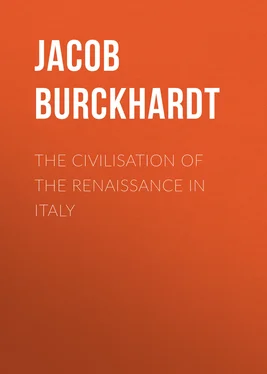Jacob Burckhardt - The Civilisation of the Renaissance in Italy
Здесь есть возможность читать онлайн «Jacob Burckhardt - The Civilisation of the Renaissance in Italy» — ознакомительный отрывок электронной книги совершенно бесплатно, а после прочтения отрывка купить полную версию. В некоторых случаях можно слушать аудио, скачать через торрент в формате fb2 и присутствует краткое содержание. Жанр: foreign_prose, История, foreign_edu, foreign_antique, на английском языке. Описание произведения, (предисловие) а так же отзывы посетителей доступны на портале библиотеки ЛибКат.
- Название:The Civilisation of the Renaissance in Italy
- Автор:
- Жанр:
- Год:неизвестен
- ISBN:нет данных
- Рейтинг книги:5 / 5. Голосов: 1
-
Избранное:Добавить в избранное
- Отзывы:
-
Ваша оценка:
- 100
- 1
- 2
- 3
- 4
- 5
The Civilisation of the Renaissance in Italy: краткое содержание, описание и аннотация
Предлагаем к чтению аннотацию, описание, краткое содержание или предисловие (зависит от того, что написал сам автор книги «The Civilisation of the Renaissance in Italy»). Если вы не нашли необходимую информацию о книге — напишите в комментариях, мы постараемся отыскать её.
The Civilisation of the Renaissance in Italy — читать онлайн ознакомительный отрывок
Ниже представлен текст книги, разбитый по страницам. Система сохранения места последней прочитанной страницы, позволяет с удобством читать онлайн бесплатно книгу «The Civilisation of the Renaissance in Italy», без необходимости каждый раз заново искать на чём Вы остановились. Поставьте закладку, и сможете в любой момент перейти на страницу, на которой закончили чтение.
Интервал:
Закладка:
It was wholly in the spirit of this system that the sovereign imposed his own respect for useful servants on the court and on the people. When in 1469 Borso’s privy councillor Ludovico Casella died, no court of law or place of business in the city, and no lecture-room at the University, was allowed to be open: all had to follow the body to S. Domenico, since the duke intended to be present. And, in fact, ‘the first of the house of Este who attended the corpse of a subject’ walked, clad in black, after the coffin, weeping, while behind him came the relatives of Casella, each conducted by one of the gentlemen of the Court: the body of the plain citizen was carried by nobles from the church into the cloister, where it was buried. Indeed this official sympathy with princely emotion first came up in the Italian States. 102 102 As early as 1446 the members of the House of Gonzaga followed the corpse of Vittorino da Feltre.
At the root of the practice may be a beautiful, humane sentiment; the utterance of it, especially in the poets, is, as a rule, of equivocal sincerity. One of the youthful poems of Ariosto, 103 103 Capitolo 19, and in the Opere Minore , ed. Lemonnier, vol. i. p. 425, entitled Elegia 17. Doubtless the cause of this death (above, p. 46) was unknown to the young poet, then 19 years old.
on the Death of Lionora of Aragon, wife of Hercules I., contains besides the inevitable graveyard flowers, which are scattered in the elegies of all ages, some thoroughly modern features: ‘This death had given Ferrara a blow which it would not get over for years: its benefactress was now its advocate in heaven, since earth was not worthy of her; truly, the angel of Death did not come to her, as to us common mortals, with blood-stained scythe, but fair to behold (onesta), and with so kind a face that every fear was allayed.’ But we meet, also, with a sympathy of a different kind. Novelists, depending wholly on the favour of their patrons, tell us the love-stories of the prince, even before his death, 104in a way which, to later times, would seem the height of indiscretion, but which then passed simply as an innocent compliment. Lyrical poets even went so far as to sing the illicit flames of their lawfully married lords, e.g. Angelo Poliziano, those of Lorenzo the Magnificent, and Gioviano Pontano, with a singular gusto, those of Alfonso of Calabria. The poem in question 105betrays unconsciously the odious disposition of the Aragonese ruler; in these things too, he must needs be the most fortunate, else woe be to those who are more successful! That the greatest artists, for example Lionardo, should paint the mistresses of their patrons was no more than a matter of course.
But the house of Este was not satisfied with the praises of others; it undertook to celebrate them itself. In the Palazzo Schifanoja Borso caused himself to be painted in a series of historical representations, and Hercules kept the anniversary of his accession to the throne by a procession which was compared to the feast of Corpus Christi; shops were closed as on Sunday; in the centre of the line walked all the members of the princely house (bastards included) clad in embroidered robes. That the crown was the fountain of honour and authority, that all personal distinction flowed from it alone, had been long 106expressed at this court by the Order of the Golden Spur—an order which had nothing in common with mediæval chivalry. Hercules I. added to the spur a sword, a gold-laced mantle, and a grant of money, in return for which there is no doubt that regular service was required.
The patronage of art and letters for which this court has obtained a world-wide reputation, was exercised through the University, which was one of the most perfect in Italy, and by the gift of places in the personal or official service of the prince; it involved consequently no additional expense. Bojardo, as a wealthy country gentleman and high official, belonged to this class. At the time when Ariosto began to distinguish himself, there existed no court, in the true sense of the word, either at Milan or Florence, and soon there was none either at Urbino or at Naples. He had to content himself with a place among the musicians and jugglers of Cardinal Ippolito till Alfonso took him into his service. It was otherwise at a later time with Torquato Tasso, whose presence at court was jealously sought after.
CHAPTER VI.
THE OPPONENTS OF TYRANNY
IN face of this centralised authority, all legal opposition within the borders of the state was futile. The elements needed for the restoration of a republic had been for ever destroyed, and the field prepared for violence and despotism. The nobles, destitute of political rights, even where they held feudal possessions, might call themselves Guelphs or Ghibellines at will, might dress up their bravos in padded hose and feathered caps 107or how else they pleased; thoughtful men like Macchiavelli 108knew well enough that Milan and Naples were too ‘corrupt’ for a republic. Strange judgments fall on these two so-called parties, which now served only to give an official sanction to personal and family disputes. An Italian prince, whom Agrippa of Nettesheim 109advised to put them down, replied that their quarrels brought him in more than 12,000 ducats a year in fines. And when in the year 1500, during the brief return of Ludovico Moro to his States, the Guelphs of Tortona summoned a part of the neighbouring French army into the city, in order to make an end once for all of their opponents, the French certainly began by plundering and ruining the Ghibellines, but finished by doing the same to their hosts, till Tortona was utterly laid waste. 110In Romagna, the hotbed of every ferocious passion, these two names had long lost all political meaning. It was a sign of the political delusion of the people that they not seldom believed the Guelphs to be the natural allies of the French and the Ghibellines of the Spaniards. It is hard to see that those who tried to profit by this error got much by doing so. France, after all her interventions, had to abandon the peninsula at last, and what became of Spain, after she had destroyed Italy, is known to every reader.
But to return to the despots of the Renaissance. A pure and simple mind, we might think, would perhaps have argued that, since all power is derived from God, these princes, if they were loyally and honestly supported by all their subjects, must in time themselves improve and lose all traces of their violent origin. But from characters and imaginations inflamed by passion and ambition, reasoning of this kind could not be expected. Like bad physicians, they thought to cure the disease by removing the symptoms, and fancied that if the tyrant were put to death, freedom would follow of itself. Or else, without reflecting even to this extent, they sought only to give a vent to the universal hatred, or to take vengeance for some family misfortune or personal affront. Since the governments were absolute, and free from all legal restraints, the opposition chose its weapons with equal freedom. Boccaccio declares openly 111‘Shall I call the tyrant king or prince, and obey him loyally as my lord? No, for he is the enemy of the commonwealth. Against him I may use arms, conspiracies, spies, ambushes and fraud; to do so is a sacred and necessary work. There is no more acceptable sacrifice than the blood of a tyrant.’ We need not occupy ourselves with individual cases; Macchiavelli, 112in a famous chapter of his ‘Discorsi,’ treats of the conspiracies of ancient and modern times from the days of the Greek tyrants downwards, and classifies them with cold-blooded indifference according to their various plans and results. We need make but two observations, first on the murders committed in church, and next on the influence of classical antiquity. So well was the tyrant guarded that it was almost impossible to lay hands upon him elsewhere than at solemn religious services; and on no other occasion was the whole family to be found assembled together. It was thus that the Fabrianese 113murdered (1435) the members of their ruling house, the Chiavistelli, during high mass, the signal being given by the words of the Creed, ‘Et incarnatus est.’ At Milan the Duke Giovan Maria Visconti (1412) was assassinated at the entrance of the church of San Gottardo, Galeazzo Maria Sforza (1476) in the church of Santo Stefano, and Ludovico Moro only escaped (1484) the daggers of the adherents of the widowed Duchess Bona, through entering the church of Sant’ Ambrogio by another door than that by which he was expected. There was no intentional impiety in the act; the assassins of Galeazzo did not fail to pray before the murder to the patron saint of the church, and to listen devoutly to the first mass. It was, however, one cause of the partial failure of the conspiracy of the Pazzi against Lorenzo and Guiliano Medici (1478), that the brigand Montesecco, who had bargained to commit the murder at a banquet, declined to undertake it in the Cathedral of Florence. Certain of the clergy ‘who were familiar with the sacred place, and consequently had no fear’ were induced to act in his stead. 114
Читать дальшеИнтервал:
Закладка:
Похожие книги на «The Civilisation of the Renaissance in Italy»
Представляем Вашему вниманию похожие книги на «The Civilisation of the Renaissance in Italy» списком для выбора. Мы отобрали схожую по названию и смыслу литературу в надежде предоставить читателям больше вариантов отыскать новые, интересные, ещё непрочитанные произведения.
Обсуждение, отзывы о книге «The Civilisation of the Renaissance in Italy» и просто собственные мнения читателей. Оставьте ваши комментарии, напишите, что Вы думаете о произведении, его смысле или главных героях. Укажите что конкретно понравилось, а что нет, и почему Вы так считаете.












